
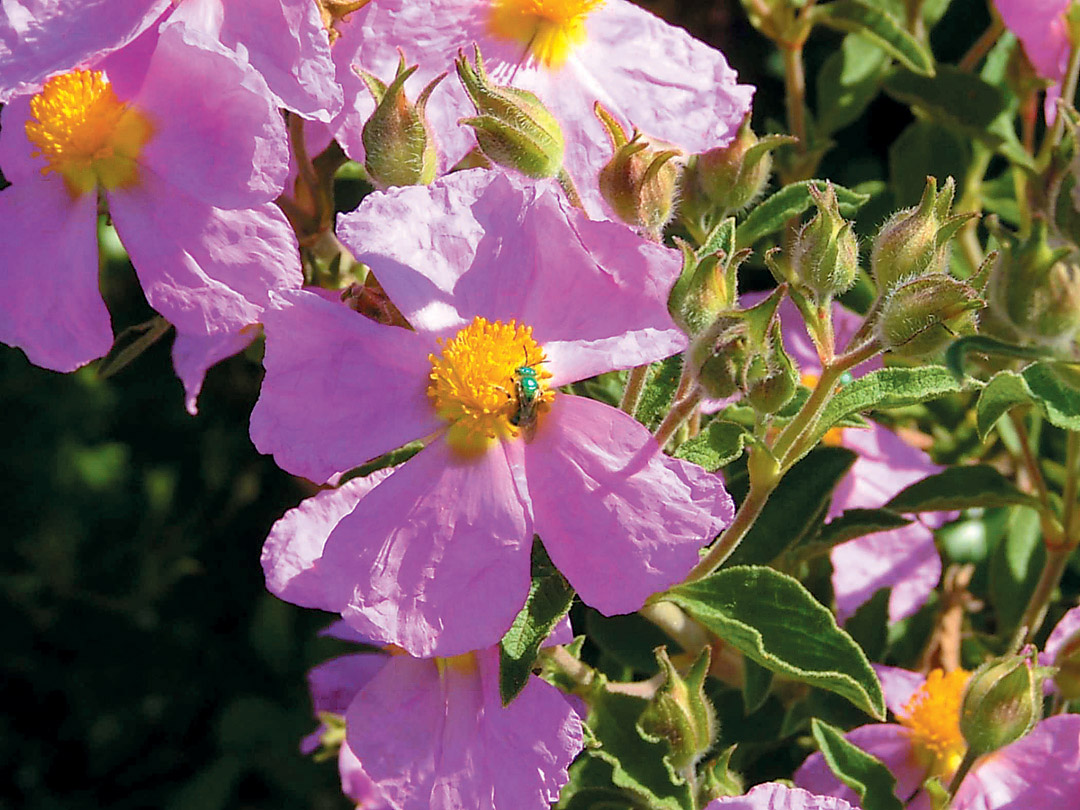
Contributor
- Topics: Archive, Plants You Need
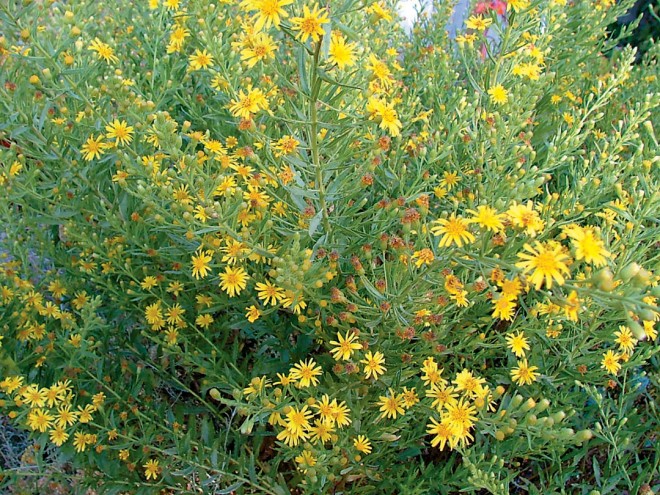
While used in recent years for perfumes, biocosmetics, pharmaceuticals, and medical research, the plants of the maquis are deeply ingrained in Corsica’s folklore as a source of food, medicine, and cultural identity. They also add beauty and wildlife value to my own Seattle garden.
The bees were a surprise. For years, I had been fascinated by the wild plants of Corsica’s “maquis” countryside, a scruffy scrubland that covers approximately twenty percent of this Mediterranean island. Watching them thrive in decomposed granite soils under a constant sun convinced me that they were the ultimate in fragrant, drought-tolerant, low-maintenance plants. After experimenting with their hardiness in Seattle, I quickly became dependent on their scents to get me through our gray winter days. Once mature, they offered an unexpected bonus: my yard became a haven for a multitude of bees and other pollen eaters. This was a surprise, because bees are not especially noticeable in the Corsican maquis, and many of these visitors were types I had never seen in Seattle, all creating a contented, buzzing community within my city garden.
To understand maquis plants, one must first connect them to the land from which they came. A French island off the coast of Italy just north of Sardinia, Corsica is an undeveloped environmental paradise whose highest elevations are dominated by craggy granite mountains skirted by forests of pine, green oak, or chestnut. Lower on the slopes, the middle maquis presents vast acres of heathers (Erica spp.), myrtles (Myrtus spp.) and strawberry trees (Arbutus unedo) growing so closely together that the hillsides are almost impenetrable, save for barely discernible shepherds’ paths. Closest to the sea, where golden sand beaches frame turquoise bays, the lower maquis offers a variety of compact, aromatic herbs—a living potpourri that perfumes the countryside. The scent, noticeable the minute one steps from the plane, is the essence of Corsica. Even Napoleon in exile was said to have longed for the smell of his beloved maquis. Is it any wonder I wanted to bring this into my own garden?
Luck was with me. While Corsica is thousands of miles from my Seattle home, our wet winters and long, dry summers so mimic Mediterranean weather patterns that many of these plants can flourish here—as long as they are provided with a sheltered, sunny location (Seattle’s winters are colder than Corscia’s), gravel-amended soil, and room to grow. Many Corsican sun-loving maquis plants can be obtained from area nurseries or through mail-order sources. Corsican mint (Mentha requienii) and Corsican hellebore (Helleborus argutifolius) are familiar to gardeners throughout the West Coast. Other options range from tall shrubs, such as true myrtle and strawberry tree, to a variety of smaller shrubs and herbaceous plants including: rue, rockroses, Spanish lavender (Lavandula stoechas), rosemary (Rosmarinus officinalis), dwarf calamint, curry plant, heathers, mints, and sages (Salvia spp.). Following are some that have been particularly successful in my own garden.
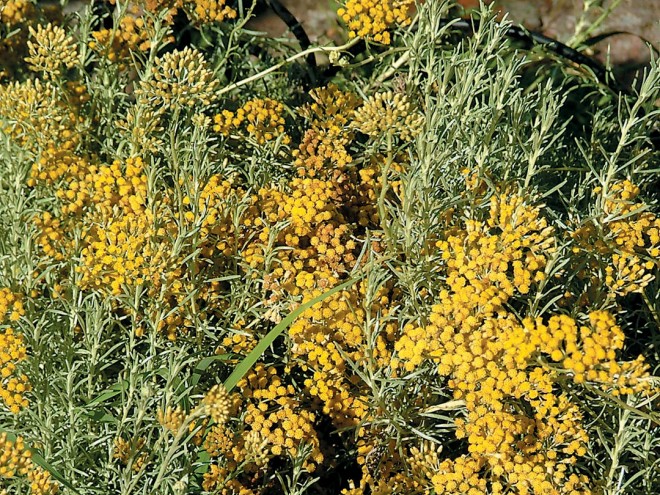
Curry Plants and Rockroses
Curry plant (Helichrysum italicum) is commonly known on Corsica as l’immortelle d’Italie. It offers year-round fragrance and long-lasting blooms suggestive of strawflowers. While its sweet curry scent drifts upon the breeze, I can never resist running my fingers through its foliage to release a stronger aroma. As summer progresses, fresh golden yellow flowers weave through faded bouquets of an antique mustard tint, creating a delicate floral tapestry above leaves of sea-foam silver.
In Corsica, curry plant flourishes along the edges of roads and pathways. In your own garden, placing it near a walkway in full sun allows easy access to its scent. Considered a medicinal herb, its flavor is decidedly uncurry like! The scent and high oil properties have been used over the years for expectorants, cough medicines, perfume and air purification, and in the smoking of meats. Growing taller—yes, even scraggly—in Pacific Northwest gardens, I found that staking the flower stalks helps maintain their beauty through the summer months. As with lavender, a light fall trim refreshes the plants for spring’s new growth.
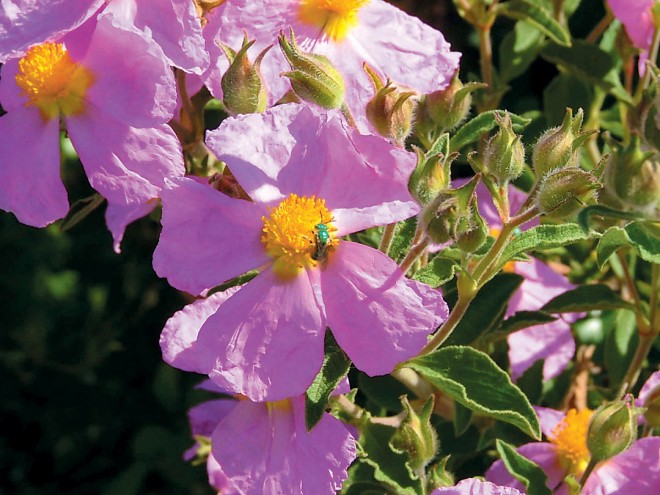
Two Corsican rockroses are stars in my garden, offering beauty with little maintenance. At any time of year, a pinch of their evergreen leaves releases the scent; as the weather warms, the production of aromatic oils in the leaves increases enough to perfume the air with no added help. Fragrance levels can vary throughout the day, depending on the temperature. In the wilds of Corsica, rockroses are signature plants of the maquis, scenting the countryside in vast drifts.
Hoary rockrose (Cistus creticus), also known locally as ciste velu and muchju rossu, is widespread around the Mediterranean Sea. Large oval, fuzzy leaves offer a sweet fragrance reminiscent of roses and sandalwood. In spring, the pinkish purple flowers have a nearly visible ultraviolet glow—most noticeable when the air is electric, right before a storm. Normally growing to three feet on Corsica, in the Pacific Northwest, it approaches six feet, with taller branches bending over and increasing a plant’s width. Strategic pruning will prevent this attractive shrub from taking over its allotted spot in the garden.
Another common Mediterranean species (Cistus monspeliensis) is known as ciste de Montpellier and muchju neru. This narrow-leafed rockrose, with slender new branches, sports cinnamon-colored bark. Its fragrance, from a sharp, earthy oil, is much more pronounced than C. creticus; the oil makes the leaves a bit sticky in warm weather. Along Corsica’s secluded dirt roads bordering the sea, this scent dominates, and, when encountered in my garden, brings me back to the island. Smaller white flowers with yellow stamens offer a surprisingly delicate scent of lemons—once your nose gets close enough. This slower-growing rockrose is more manageable in my garden, reaching approximately four feet tall by two feet wide, with no pruning necessary.
Because these two rockroses flower at the same time, I relish watching big bees (such as bumblebees), flock to the larger blossoms, while the smallest bees (about the size of a sharpened pencil lead) appear to prefer flowers closer to their own size. One colorful bee-like insect of metallic aqua is most appreciative of the large rockroses, returning repeatedly through-out their flowering season, despite the fact that my garden is filled with other blossoms.
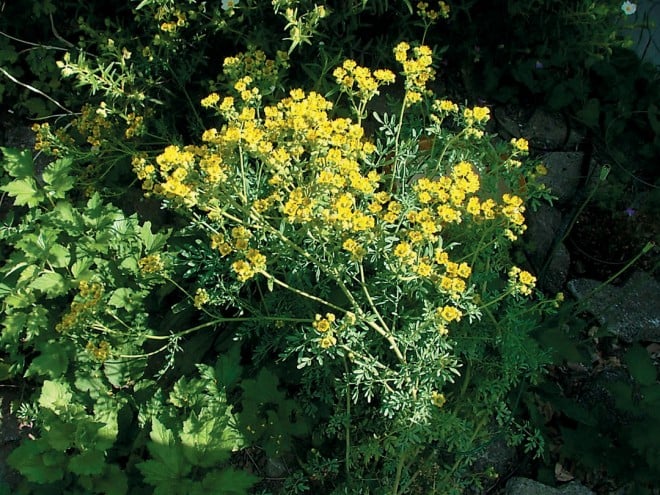
An Aster, A Mint, and Rue
From the aster family comes sticky fleabane (Inula viscosa), which Corsicans call inule visqueuse. I would grow this plant for its fragrant leaves alone, but, from August to the end of October, its cheery yellow flowers are nothing short of magical. New shoots emerge each spring from the ground (I prune to six-inch stubs in late fall); it reaches a towering six by six feet in late August, covered in blossoms that progress upwards along each stem. (When grown indoors, it stays evergreen and a manageable twelve inches in height for many years.) It is a virtual stop-sign for bee-like insects, including many wondrous kinds that were new to me: black and white, orange-striped, metallic aqua (my repeat visitor from the rockrose), tiny bees, large glossy black bumblebees, fuzzy honeybees, gold and black bumblebees. When the sun hits this aster, its golden flowers attract one and all— but especially me.
For the rest of the year, its scent is compelling. No matter how long or deeply I inhale, the description escapes me: perhaps a combination of musk and skunk cabbage with a sweet rose overtone? Surely a come-hither combination for insects as well as humans! In Corsica, plants colonize along stony hillside slopes and roadsides—always a bit smaller and shabbier than in my own garden. The reported medicinal uses for this species range from diuretics to topical anti-itching agents and a treatment for surface wounds.
When I first discovered dwarf calamint (Calamintha nepeta), I thought it was just another mint, albeit with smaller leaves and intriguing lavender, orchid-like flowers. My interest grew after sampling its leaves; their extra zesty mint essence lures me outside, even in the middle of winter. One winter, when temperatures were in the low 20s F with five inches of snow on the ground, I was stunned to see the sun shining on its fully formed leaves. Yet, my other mints were brown leafless sticks—far from inviting. After reviewing my Corsican references, I discovered that the genus Calamintha, which is related to the mints (Mentha), is reportedly hardy to temperatures below 0° F. Preferring a sunny location in well-drained soil, this species is noted for attracting an array of pollinating insects. Also popular with Corsican cooks, it is included in recipes such as herbal or fish soups, sauces, and omelets, or served atop bread with olive oil.
Rue (Ruta graveolens) is a fairly new introduction to my garden. The delicate tracery of blue green leaves adds an appealing contrast amongst larger gray-leafed plants. I first saw rue in the woods near a monastery on Corsica—a fitting location given the spiritual quality attributed to it. I especially enjoy rue’s unique fragrance, which is reminiscent of a sharp, celery scent. Corsicans have used it for medicinal tisanes and for mixing with fennel to treat eye diseases. Doctors use its vitamin P (bioflavonoid) properties for treating circulation and hypertension problems. (Ingestion of large quantities, however, is not recommended.)
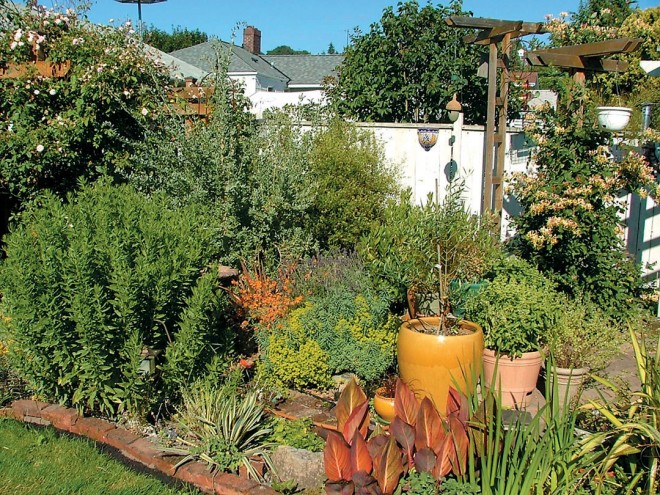
The Dominant Maquis Shrubs
Strawberry tree (Arbutus unedo), a common companion to myrtle on Corsica’s hillsides, is an evergreen shrub or small tree that can range from eight to twenty feet in height, depending on conditions. It offers globular, strawberry-like fruits that change from cream to red as they mature, often ripening as the next crop of waxy white, urn-shaped flowers appear. Many strawberry trees grow along Corsica’s paved roadways, providing wandering long-haired goats easy access to their bounty of fruit. While the fruit is a bit mushy for eating fresh, Corsicans do make jams, wines, and liqueurs from the abundant fruit.
It took years for me to identify true myrtle in the maquis, mainly because it was never in fruit during my visits; it was really all around me. All I needed to do was breathe: its evergreen leaves provide a blueberry-like fragrance year-round. Fragrant white flowers lead to the sweet deep blue fruits that contain vitamin C and antioxidants. Corsicans have a couple of other uses for what they call myrte: fashioning wreathes, complete with berries, and, most importantly, creating the popular Corsican drink, liqueur de myrte. (It smells as good as it tastes!) While still small, my myrtles have withstood our harsh winters with no problems, and I dream of the day when they become a luxuriant, fragrant hedge for all to enjoy.
These are only a few of the many intriguing plants of Corsica. Each unique and beautiful, they blend to establish the terroir of this intriguing island. Worlds away in Seattle, life is more hectic. Yet, no matter what task brings me outside, I am lured to my Corsican plants “in bee.” Stepping up to each plant, I calmly inhale their parfum de maquis until the noises fade, and my world becomes as peaceful as the Corsican countryside. There, among the aerobatics of the pollinators, life’s stresses drift away with the scented breeze. As I listen to the bees’ songs, each in a different key, I need not understand their language to know they are singing thanks for these Corsican flowers. Together, we look forward to the coming years in my garden where we can just bee.
To learn more about Corsica’s plants or other pleasures, view island photographs, or discover other websites devoted to Corsica: visit the author’s website, www.fleurdecorse.com.
Share:
Social Media
Garden Futurist Podcast
Most Popular
Videos
Topics
Related Posts

Ground Up Science for Greener Cities with Garden Futurist Dr. Alessandro Ossola
Spring 2023 Listen to the Podcast here. Alessandro Ossola is a scientist who gets very excited about the challenge of climate change allowing for an

Readying Urban Forests for Climate Realities with Garden Futurist Dr. Greg McPherson
Winter 2023 Listen to the Podcast here. “Going from the mow and blow to a more horticulturally knowledgeable approach to maintaining the landscape. And that

Low Maintenance Gardens – Better for Pollinators and People
Autumn 2022 “I come out every day. It’s therapy, my meditation.” Janet’s young garden transformed from overgrown, invasive plants to mostly natives. The dailiness of

Invasive Plants Are Still Being Sold: Preventing Noxious Weeds in Your Landscape
Autumn 2022 With so many beautiful ornamental plant species and cultivars throughout California and the Pacific Northwest, how do you decide which ones to include








Responses